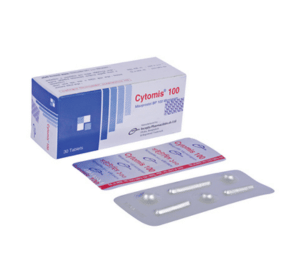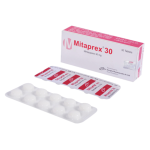Cytomis(Misoprostol)

Therapeutic Group: Gynaecological
Presentation
Cytomis 100 : Each tablet contains Misoprostol BP 100 mcg.
Cytomis 200 : Each tablet contains Misoprostol BP 200 mcg.
Description
Misoprostol is a synthetic prostaglandin E1 analogue that has gastric antisecretory, mucosal protective and uterine contractibility properties. The antisecretory activity and uterine contractibility of Misoprostol is mediated through a class of high affinity E- type prostaglandin receptors on the surface of gastric parietal cells and uterus respectively. Misoprostol achieves cytoprotection by stimulation of gastric mucus secretion, duodenal bicarbonate secretion and gastric mucosal blood flow.
Indications
Misoprostol is indicated for:
– Prophylaxis of gastric and duodenal ulceration in NSAID users at high risk of complications from gastric ulcer e.g. the elderly, patients with concomitant debilitating disease and patients with a history of ulcer.
– Healing of established NSAID- induced gastric and duodenal damage.
– Healing of gastric and duodenal ulcers in the absence of NSAID therapy.
– Induction of labor.
– Prevention and treatment of postpartum haemorrhage.
Dosage & Administration
Benign gastric and duodenal ulceration and NSAID associated ulceration: 800 mcg daily (in 2-4 divided doses) with breakfast or main meals and at bedtime; treatment should be continued for at least 4 weeks and may be continued for up to 8 weeks if required.
Prophylaxis of NSAID induced gastric and duodenal ulcer: 200 mcg 2-4 times daily taken with NSAID. If this dose cannot be tolerated, a dose of 100 mcg can be used. Misoprostol should be taken for the duration of NSAID therapy as prescribed by the physician.
Induction of labor:
Place 25 mcg in the posterior fornix of the vagina. Repeat after every 6 hours if necessary until the maximum dosage of 200 mcg total misoprostol is reached. Fetal heart rate and uterus contractions should be monitored. Alternatively, 100 mcg taken orally. If cervical ripening or active labor does not occur, repeated dose of 100- 200 mcg of oral misoprostol is given every 4 hourly until labor is established (as evidenced by a Bishop score of 7 or more). Maximum number of dose is 6. Maternal vital signs, fetal heart rate and contractions should be monitored. Oxytocin can be started 4 hours after last dose of misoprostol. Physician should be notified for signs of fetal distress or tetanic uterine contractions. Oral misoprostol therapy should be monitored by Physician.
Prevention of postpartum haemorrhage: 600 mcg orally immediately following delivery.
Treatment of postpartum haemorrhage: 600 mcg orally or 1000 mcg per rectally.
Use in children: Safety and effectiveness of Misoprostol in children below the age of 18 years have not been established.
Side Effects
Generally, Misoprostol is well tolerated. The most frequent adverse effects associated with Misoprostol therapy involve the GI tract such as, diarrhea, abdominal pain, dyspepsia, flatulence, nausea, vomiting, rashes and dizziness. The incidence of diarrhea may be minimized by administering the drug after meal and at bedtime and by avoiding concomitant administration with a magnesium-containing or other laxative antacid.
Precautions
Incase of prevention and treatment of NSAID induced gastric and duodenal ulcer: Misoprostol is contraindicated in women who are pregnant, and should not be used in women of child bearing potential unless the patient requires NSAID therapy. Women of child bearing potential should be told that they must not be pregnant when Misoprostol therapy is initiated and they must use an effective contraception method while taking misoprostol.
Incase of induction of labor:
The pregnancy should have completed 38 weeks gestation by reliable dating, or lung maturity as evidenced by a L/S> 2.0 or a positive phosphotidyl glycerol test, or completed 36 weeks gestation with a maternal or fetal medical indication for induction of labor. Induction of labor is contraindicated in acute fetal distress, abruptio placenta, placenta previa or unexplained vaginal bleeding. The fetus should be in vertex presentation.
Use in Pregnancy & Lactation
Pregnancy: Misoprostol is contraindicated to pregnant women.
Lactation: It is not known whether Misoprostol\’s active metabolite- misoprostol acid is excreted in human milk. Misoprostol should not be administered to nursing mothers because the excretion of misoprostol acid could cause diarrhea in nursing infants.
Drug Interaction
There is no evidence of clinically significant interaction between Misoprostol and cardiac, pulmonary, CNS drugs and NSAID\’s. Bioavailability of Misoprostol is decreased with high doses of antacid.
Over Dose
The toxic dose of Misoprostol in human has not been determined. Clinical signs that may indicate an overdose are sedation, tremor, convulsions, dyspnea, abdominal pain, diarrhea and fever. Symptoms should be treated with supportive therapy.
Commercial Pack
Cytomis 100: Each box contains 10 Alu-Alu blister strips of 3 tablets.
Cytomis 200: Each box contains 3 Alu-Alu blister strips of 10 tablets.



